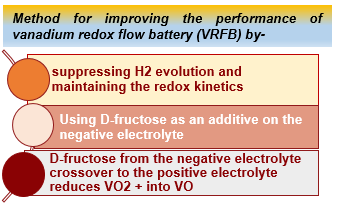Industrial Consultancy & Sponsored Research (IC&SR) , IIT Madras
Technology Category/ Market
Category –Energy, Energy Storage & Renewable Energy
Applications –Buffering output utility-scale wind and solar systems, grid energy storage, power backup for commercial buildings, Electric vehicles, mobile phone masts
Industry – Automobiles, Clean Energy
Market -The global redox flow battery market size was valued at $130.4 million in 2018, and is projected to reach $403.0 million by 2026, growing at a CAGR of 15.2% from 2019 to 2026
Image Gallery
Problem Statement
- Vanadium redox flow battery (VRFB) systems are considered as promising energy storage systems, where the energy and power capability of the VRFB can be decoupled providing greater flexibility in matching the energy requirement need of the specific applications.
- Commercially available VRFB systems have limitations of high cost and capacity decay.
- Also, there is significant issue is the imbalance between the V2+/V3+ redox reaction and hydrogen (H2) evolution during charging, leading to the accumulation of residual VO2+ in the positive electrolyte and contributing to capacity loss.
Technology

- Graphite felt based electrodes are used both on negative and positive electrolyte and the additive D-fructose is added to the negative electrolyte on the graphite felt
- D-fructose controls the VO2 + accumulation at the positive electrolyte by redox reaction between crossed-over D-fructose with VO2
- Electrolyte membrane used for D-fructose crossover from the negative to positive electrolyte is Nafion-117 ion exchange membrane.
- The additive includes D -fructose and other monosaccharide such as glucose, mannose etc
Key Features/ Value Proposition
Technical Perspective:
- D-fructose enhances the wettability of the negative electrode which increases the contact area of the electrode-electrolyte interface, thereby increasing the current observed due to V2+ /V3+ redox reaction
- Optimization of the concentration of additive in the negative electrolyte improves the cyclability and capacity retention of the vanadium redox flow battery (VRFB)
Industrial Perspective:
- Reduction of H2 evolution and redox balancing of the electrolyte solutions alleviate the frequent chemical conditioning of the positive electrolyte required to maintain the VRFB performance
- Stabilized discharge capacity and excellent capacity retention over cycles and cost efficient
Questions about this Technology?
Contact For Licensing
sm-marketing@imail.iitm.ac.in
ipoffice2@iitm.ac.in
Research Lab
Prof. Kothandaraman Ramanujam
Department of Chemistry
Intellectual Property
- IITM IDF Ref. 1406
- IN404775-Granted
Technology Readiness Level
TRL-3
Experimental Proof of Concept
